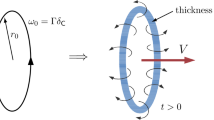Abstract
We prove the existence of local in time solution to Kolmogorov’s two-equation model of turbulence in three dimensional domain with periodic boundary conditions. We apply Galerkin method for appropriate truncated problem. Next, we obtain estimates for a limit of approximate solutions to ensure that it satisfies the original problem.
Similar content being viewed by others
References
Wilcox, D. C.: Turbulence Modeling for CFD, DCW Industries, Inc, ISBN: 978-1-928729-08-2 , (2006)
Davidson, L.: Fluid Mechanics. Lecture Notes in MSc courses, Chalmers University of Technology, Sweden, Turbulent Flow and Turbulence Modeling (2013)
Versteeg, H.K., Malalasekera, W.: An Introduction to Computational Fluid Dynamics, Second Edition, Prentice Hall, (2007)
Tuncer, C.: Turbulence models and their application. Springer, Berlin, Heidelberg (2004)
Kolmogorov, A.N.: Equations of turbulent motion in an incompressible fluid, Izv. Akad. Nauk SSSR, Seria fizicheska 6 (1-2) (1942) 56-58
Spalding, D.B.: Kolmogorov’s two-equation model of turbulence. Proc. Roy. Soc. London Ser. A 434(1890), 211–216 (1991)
Bulicek, M., Malek, J.: Large data analysis for Kolmogorov’s two equation model of turbulence. Nonlinear Anal. Real World Appl. 50, 104–143 (2019)
Mielke, A., Naumann, J.: On the existence of global-in-time weak solutionsand scaling laws forKolmogorov’s two-equation model of turbulence, arXiv:1801.02039, (2018)
Mielke, A., Naumann, J.: Global-in-time existence of weak solutions to Kolmogorov’s two-equation model of turbulence. C. R. Math. Acad. Sci. Paris 353(4), 321–326 (2015)
Foias, C., Manley, O., Rosa, R., Temam, R.: Navier-Stokes equations and turbulence, Encyclopedia of Mathematics and its Applications. Cambridge University Press, Cambridge (2001)
Acknowledgements
The authors would like to thank the anonymous referee for valuable remarks, which significantly improve the paper.
Author information
Authors and Affiliations
Corresponding author
Additional information
Communicated by David Lannes.
Publisher's Note
Springer Nature remains neutral with regard to jurisdictional claims in published maps and institutional affiliations.
Appendix
Appendix
The function \(\Psi _{t}\) may be defined as follows. We set \(f(x)= e^{-1/x}\) for \(x>0\) and zero elsewhere. We put \(g(x)= x-e^{-1/x}\) for \(x<0\) and \(g(x)=x\) for \(x>0\). Then we set
where \(c=\int _{0}^{1} f(y)f(-y+1)dy\). Function \(\tilde{\eta } \) is smooth function, which vanishes for negative x and is equal to one for \(x>1\). Next, we put
Finally, we define
Rights and permissions
About this article
Cite this article
Kosewski, P., Kubica, A. Local in time solution to Kolmogorov’s two-equation model of turbulence. Monatsh Math 198, 345–369 (2022). https://doi.org/10.1007/s00605-022-01703-3
Received:
Accepted:
Published:
Issue Date:
DOI: https://doi.org/10.1007/s00605-022-01703-3




